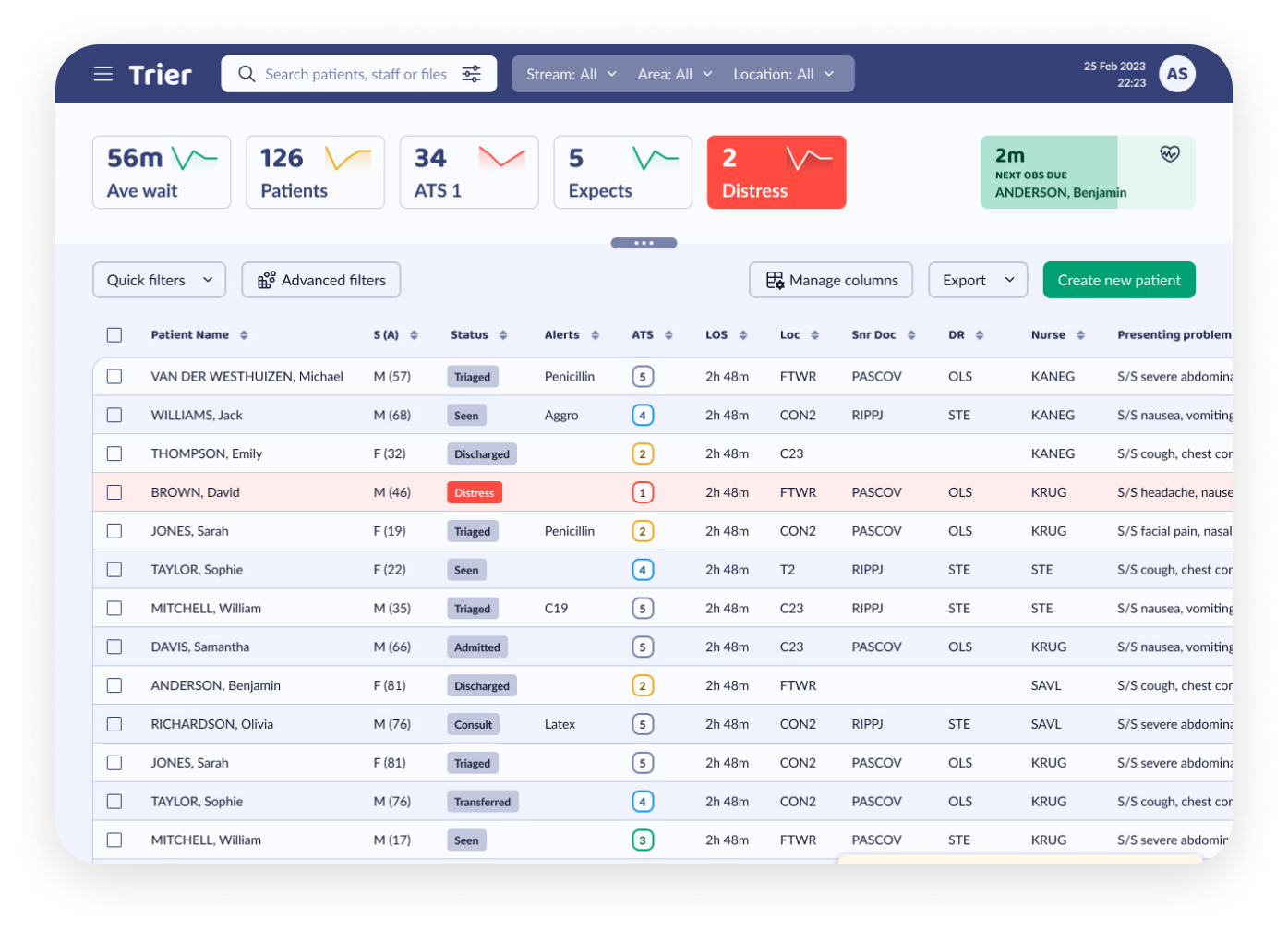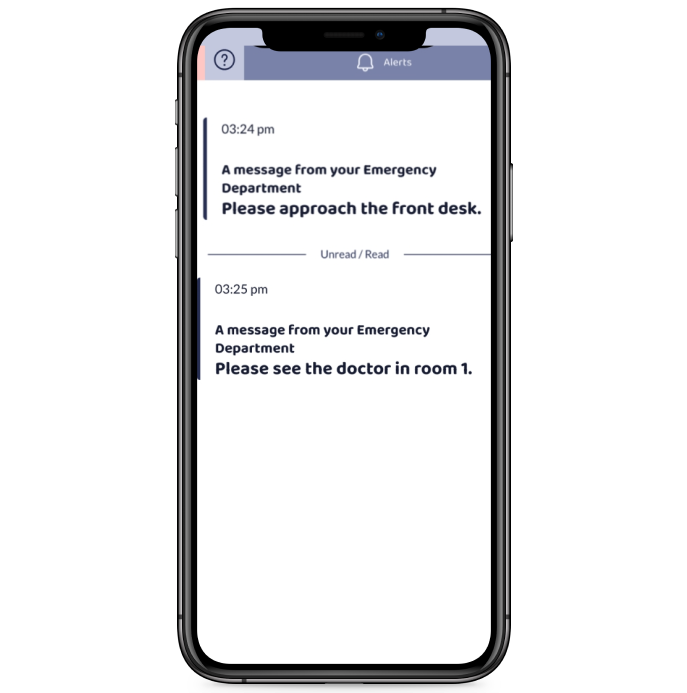.png?width=600&height=500&name=Frame%2037%20(1).png)
Trier Medical was founded by Emergency Department professionals to improve Emergency Department (ED) operations by improving safety, communication, and efficiency in ED waiting rooms through innovative technology solutions.
The combined experience of Dr James Rippey and Dr Ovi Pascu ensured that their product, My Emergency Visit (MEV), was designed for the hospital staff who will be using it.
The goal is to improve waiting room safety. MEV enhances the safety and efficiency of EDs by enabling virtual care and better communication between patients and clinicians.
What is MEV?
Transforming Emergency Care
-
Integrated Clinician Portal
MEV's clinician portal integrates with existing hospital systems, supporting informed decision-making and enabling a more coordinated and efficient approach to patient care.

-
Real-Time Alerts
MEV provides real-time alerts to clinicians for signs of acute deterioration, allowing for timely interventions and improved patient safety. The platform also enables patients to instantly notify clinicians if their condition worsens.
.png?width=687&height=490&name=Frame%2038%20(9).png)
-
Waiting Time Updates
Patients are kept informed of their expected wait times through real-time updates provided by the MEV app. This transparency helps reduce patient anxiety and uncertainty, making their waiting experience less stressful.
.png?width=687&height=693&name=Frame%2039%20(5).png)
-
Seamless Communication
MEV synchronises patient information with the clinical portal, enabling open communication and enhancing both quality of care and overall ED efficiency.


.png?width=687&height=490&name=Frame%2038%20(9).png)
.png?width=687&height=693&name=Frame%2039%20(5).png)

Key Outcomes
The launch of My Emergency Visit (MEV) into WA Health marks a significant milestone for Trier Medical and Imminently. The MEV concept was not just about integrating technology into healthcare; it was about reshaping the emergency department experience around the needs and expectations of patients and clinicians, setting a new standard for patient-centred care.

Reduced Triage Time
Achieved a 30%+ reduction in hospital ramping within 1 month of operation. This means faster, more efficient care for everyone.

Enhanced Patient Safety
Clinicians receive instant notifications on any signs of patient deterioration, ensuring timely interventions and reducing the risk of adverse outcomes in crowded waiting rooms.

Improved Communication
Integrates with existing hospital systems, streamlining the flow of information and reducing the need for patients to repeat their medical history.

Scalable and Secure
Easily scaled across hospital networks, with a robust backend deployed on the hospital’s preferred cloud, ensuring data security and compliance.
How My Emergency Visit Works
Patient Process
-
.png?width=400&height=533&name=Frame%2041%20(3).png) The patient providestheir details andsymptoms via app
The patient providestheir details andsymptoms via app -
 Patient-supplied photoshelp to identify the patient,and give more informationon their condition
Patient-supplied photoshelp to identify the patient,and give more informationon their condition -
.png?width=400&height=533&name=Frame%2043%20(3).png) Supply background byanswering furtherquestions whilst waiting
Supply background byanswering furtherquestions whilst waiting -
 Receive in-app (push)and SMS notificationsfrom the hospital
Receive in-app (push)and SMS notificationsfrom the hospital
How My Emergency Visit Works
Clinician Process
-
.png?width=1024&height=768&name=Slide%204_3%20-%201%20(1).png) Manage and triagenew patient admissions
Manage and triagenew patient admissions -
.png?width=1024&height=768&name=Slide%204_3%20-%202%20(1).png) Nurses observe patientvitals and status
Nurses observe patientvitals and status
How My Emergency Visit Works
Patient Process
.png?width=600&height=546&name=Trier-poster-mock%201%20(1).png)
PILOT
Developed in conjunction with North Metro Health Services & Department of Health WA
Solution Highlights:
- Hosted as a dual-tenancy on Microsoft Azure, offering real-time triage updates
- Customised HL7 integration tailored to WA Health's specific needs
- Stringent data and clinical safety protocols to meet the highest security and privacy standards
- Designed for scalability, ready for adoption across Australia and beyond.
.png?width=300&height=33&name=Group%2010%20(3).png)
.png?width=700&height=800&name=Frame%201000002008%20(8).png)
Success Story
MEV Launch Success Mentioned in Parliament
Emergency Care Navigation Centre launched at Sir Charles Gairdner Hospital marking a significant leap forward in emergency medicine. With plans to expand this technology to Fiona Stanley Hospital and beyond, Trier Medical's approach exemplifies how leveraging technological advancements can revolutionise healthcare, promising a more efficient and seamless experience for patients and clinicians across the nation.
.png?width=700&height=800&name=Frame%201000002009%20(1).png)
Success Story
Trier Exclusive on 9 News
Trier Medical's My Emergency Visit (MEV) app has been a game-changer for emergency triaging. Its deployment at Sir Charles Gairdner Hospital has impressively cut ambulance ramping by 49%, a significant milestone that is a testament to the team's dedication and the transformative impact of this technology.
.png?width=220&height=82&name=Group%20(4).png)